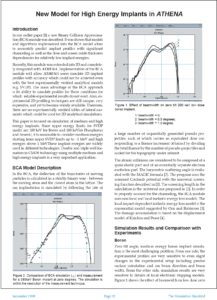New Model for High Energy Implants in ATHENA
Introduction
In our earlier paper [1] a new Binary Collision Approximation (BCA) module was described. It was shown that models and algorithms implemented into the BCA model allow to accurately predict implant profiles with significant channeling as well as the dose and screen oxide thickness dependencies for relatively low implant energies.
Recently, this module was extended into 2D and completely integrated with ATHENA. Implementation of the BCA module will allow ATHENA users simulate 2D implant profiles with accuracy which could not be achieved even with the best experimentally verified analytical models (e.g. SVDP). The main advantage of the BCA approach is its ability to simulate profiles for those conditions for which reliable experimental results do not exist. Also, experimental 2D profiling techniques are still unique, very expensive, and yet to become widely available. Therefore, there are no experimentally verified tables of lateral moments which could be used for 2D analytical simulations.



